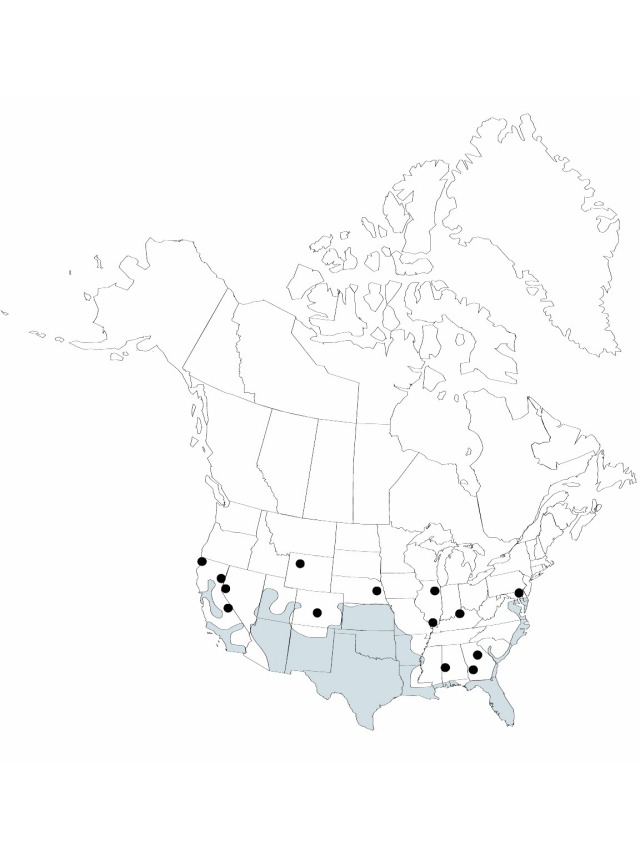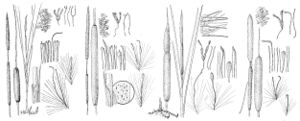Typha domingensis
Syn. Pl. 2: 532. 1807.
Erect shoots 150–400 cm, not glaucous; flowering shoots 1–2 cm thick in middle; stems 3–4 mm thick near spike. Leaves: sheath sides membranous, margin broadly clear, summit tapered to blade or with persistent, membranous auricles; mucilage glands at sheath-blade transition orangebrown, numerous on entire sheath and proximal 1–10 cm of blade; widest blades on shoot 6–18 mm wide when fresh, 5–15 mm when dry; distal blade about equaling inflorescence. Inflorescences: staminate spike separated from pistillate by (0–) 1–8 cm of naked axis, ca. 1.4 X longer than pistillate, 1 cm thick at anthesis; staminate scales straw-colored to mostly bright orangebrown, variable in same spike, linear to cuneate, often laciniate distally, to 3–4 × 0.3 mm; pistillate spikes in flower when fresh bright cinnamon-brown with whitish stigmas (drying brownish), later orange (to medium) brown, in fruit generally paler as stigmas and often bracteole blades wear off, ca. 6–35 cm × 5–6 mm in flower, 15–25 mm in fruit; compound pedicels in fruit peglike, ca. 0.6–0.9 mm; pistillate bracteole blades forming spike surface before flowering, later slightly exceeded by stigmas and slightly exceeding pistil-hairs, straw-colored to bright orangebrown, much paler than to nearly same color as stigmas, irregularly narrowly to broadly spatulate or lanceolate, 0.8 × 0.1–0.3 mm, mostly wider than stigmas, apex variable in same inflorescence or different plants, acute or acuminate. Staminate flowers 5 mm; anthers 2–2.5 mm, thecae yellow, apex bright orangebrown; pollen in single grains. Pistillate flowers 2 mm in flower, 8–9 mm in fruit; pistil-hair tips straw-colored to orangebrown in mass, usually with 1 subapical bright orangebrown, generally enlarged cell; stigmas often deciduous in fruit, in flower erect, elongating, bending to form surface mat, white in flower when fresh, later bright orangebrown, narrowly linear-lanceolate, ca. 1 × 0.1 mm; carpodia slightly exceeded by pistil-hairs, usually evident at fruiting spike surface, straw-colored, orange-spotted, apex broadly rounded. 2n = 30.
Phenology: Flowering spring–summer.
Habitat: Often in brackish water or wet soil
Elevation: 0–2000 m
Distribution

Ala., Ariz., Ark., Calif., Colo., Del., Fla., Ga., Ill., Kans., Ky., La., Md., Miss., Mo., Nebr., Nev., N.Mex., N.C., Okla., S.C., Tex., Utah, Va., Wyo., Mexico, West Indies, Central America, South America, West Indies, Eurasia, Africa, Pacific Islands (New Zealand), Australia
Discussion
Typha domingensis aggressively invades and forms nearly pure stands in brackish or nutrient-enriched wetlands in the Florida Everglades and elsewhere. It is established but does not mature fruits on the cold coast of northern California. There are specimens of putative hybrids with T. angustifolia beyond the main range of T. domingensis, in southeastern and northwestern Nebraska and southeastern Kentucky, and with T. latifolia in southeastern Nebraska. Vegetative T. domingensis or hybrids occur on the Atlantic Coast north as far as Delaware. (S. G. Smith, unpublished). The northern Illinois locality is a power plant cooling pond. The Wyoming record is from a hot spring and may be a hybrid with T. latifolia. Typha domingensis probably should be treated as a highly variable pantropic and warm temperate species, occurring to 40º E north and south latitude worldwide, and needing study to determine infraspecific taxa and delimitation from related species (B. G. Briggs and L. A. S. Johnson and B. G. Briggs 1968; S. G. Smith 1987). For hybrids see also genus and key.
Other References (plus corrections and additions) missing from this file. Have added and corrected these data with Bob’s 2d blue-line.
Selected References
Lower Taxa
No values specified."elongating" is not a number.
